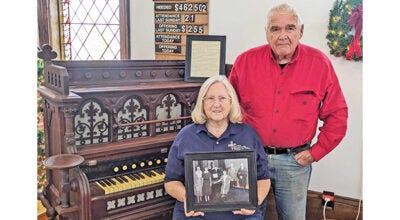‘Gardens of Eden’ replicated in region
Published 10:58 pm Thursday, April 14, 2011

The Margaret B. Upton Arboretum north St. Joseph offers views of the St. Joseph River as it makes its way to Lake Michigan. Photo by Terri Gordon
Local arboreta are good sources of inspiration and information for the home tree garden.
Historically, botanical gardens and arboretums, or arboreta, began as attempts to replicate the Garden of Eden. Unable to find that original garden, people began to collect trees and plants to impart their impressions of what it must have been like. The development of these gardens began in Italy. They spread to France, and eventually around the world. By definition, the gardens attempt to gather as many different kinds of trees and shrubs as possible.
Arboretums and botanical gardens are, in many ways, works of art — their beauty unparalleled. They are important to scientific exploration, and have been instrumental in preserving countless plant species. Fun places to visit for recreation, and for landscaping ideas, the gardens are invaluable.
At Fernwood Botanical Garden and Nature Preserve in Niles, the arboretum was specifically-designed with the home gardener in mind. Designed in the late 1960s by landscape architect Clarence Godschalk, Fernwood’s arboretum features trees “for urban landscape and for homeowners,” said Steve Bornell, head of horticulture.
Grouped by type into pine, beech, maple and other collections, the trees show visitors different varieties, as well as what they look like as mature trees. Often the trees people purchase at garden centers are little more than a “whip,” said Bornell. Fernwood provides a place people can visit and observe what those sprigs become 10 years down the line as full-grown trees.
A local arboretum with an academic leaning is found on the campus of Andrews University in Berrien Springs. The collection has grown quickly in number and diversity since its conception in the early 1990s.
The arboretum began as a way to incorporate Andrews’ academics, history and philosophy into the campus. The result is an arboretum rich in diversity and meaning. For example, outside the seminary grow trees of biblical importance, like the Cedar of Lebanon. Dennis Woodland, professor of botany at Andrews, and the arboretum’s curator, also foresees a “literary” garden, with trees and shrubs from literature, like the Chestnut tree mentioned in the poem “Hiawatha.”
Andrews’ arboretum has also become a place to preserve trees losing ground in the natural environment. Giant trees like the Red Ash have been cloned so they can be planted and preserved in the “living libraries” arboretums offer.
While trees are beautiful things in their own right, also contribute to the environment in many ways. Woodland cited findings that a tree produces a value “in the hundreds of thousands of dollars” in its average 55-year life span, “Over that life span,” explained Woodland, “that tree is pumping, into the environment, oxygen. It’s removing carbon dioxide. It’s breaking down wind movement, and it’s providing cooling.”
While arboretums are often educational, they can also be venues for recreation. At the north end of State Street in St. Joseph, the Margaret Upton Museum offers visitors a gentle, meandering park with shaded areas to sit and walk and picnic along the river channel.
Steve Byrns, a St. Joseph native and New York architect, created the arboretum in 1975 to honor his grandmother after her untimely death. His mother, Priscilla Byrns, finds it a fitting tribute to her mother, an avid gardener.
Byrns says Steve put a lot of thought into the landscaping, choosing trees that would flourish naturally in the park’s environment, like the weeping willows along the water’s edge.
Looking at the arboretum now, more than 35 years later, Byrns marvels at how the trees have grown. She’s glad the land has been preserved for the public.
“It’s a beautiful thing to look at, and it’s serene,” she said.
The arboretum is a popular spot for watching boats. People go to feed the ducks, and a lot of folks walk their dogs along the paths.
Regional Arboreta
The tri-state area offers arboreta, both large and small, for folks to visit and admire.
• The Margaret Upton Arboretum features paths along the river, boat tie-ups and picnic areas.
• The Andrews University Campus Arboretum displays roughly 1,700 trees and shrubs, including Cedar of Lebanon and Giant Sequoia from the Pacific Northwest.
• Fernwood Botanical Gardens shows trees for urban use.
• Frederick Meijer Gardens in Grand Rapids covers 125 acres, and features a world-class sculpture collection.
• Chicago Botanical Garden in Glencoe, Ill. features an oak woodland and collections of dwarf conifers and tall trees.
• Morton Arboretum in Lisle, Ill. features a Four Seasons Garden offering year-round interest for visitors.
• In Valparaiso, Ind., Taltree Arboretum strives to recreate a pre-settlement environment featuring prairie, wetlands and 250-year-old burr oak trees.
• Of international renown is Boerner Botanical Gardens, at Hales Corners (near Milwaukee), Wis.
• Also in Milwaukee is Mitchell Park Horticultural Conservatory, also known as “The Domes.”
• Michigan State University maintains the Clarence E. Lewis Landscape Arboretum on its campus in East Lansing, Mich.
• The University of Michigan at Ann Arbor is devoted to its 123-acre Nichols Arboretum.





